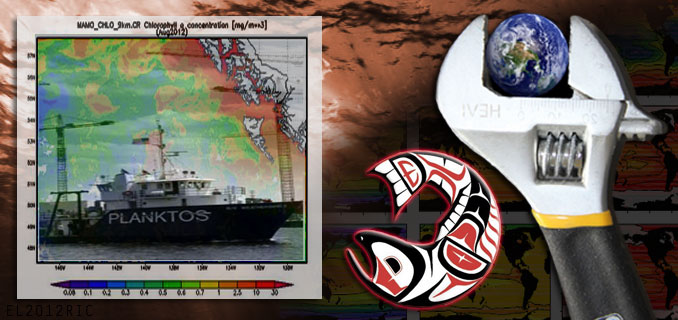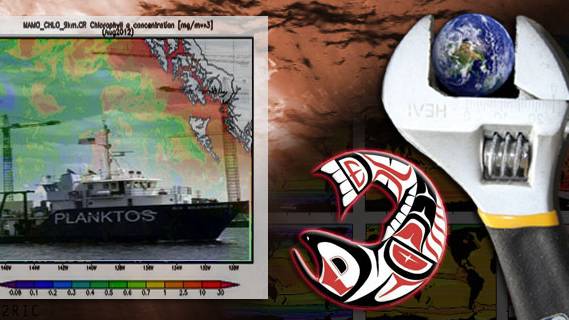A massive and illegal geoengineering project has been detected off Canada’s west coast
Source: io9.com

A private company backed by a controversial U.S. businessman has unilaterally conducted the world’s most significant geoengineering project to date. Russ George, in conjunction with a First Nations village on Haida Gwaii, has dumped around 100 tonnes of iron sulphate into the Pacific Ocean in a technique known as ocean fertilization. The experiment, which is in violation of two United Nations moratoria, has outraged environmental, legal, and civic groups.
The iron sulphate was dumped into the Pacific back in July, but recent satellite images are now confirming its effects — an artificial plankton bloom that’s 10,000 square kilometers (3,861 square miles) in size. The intention of the project is for the plankton to absorb carbon dioxide and then sink to the bottom of the ocean. George is hoping to cash in on lucrative carbon credits.
To make the project happen, George convinced the local council of an indigenous village to establish the Haida Salmon Restoration Corporation. He told them that the project would restore salmon populations, leading the First Nations people to channel more than $1m of its own money into the project.
Critics say it is a "blatant violation" of United Nations rules, and the matter is currently under investigation by Environment Canada. Experts contend that the project violates the UN’s convention on biological diversity (CBD) and London convention on the dumping of wastes at sea, which both prohibit for-profit ocean fertilisation activities. According to the Guardian, the news publication that broke the story, George claims that the two moratoria are a "mythology" and do not apply to his project. The Guardian reports:
George is the former chief executive of Planktos Inc, whose previous failed efforts to conduct large-scale commercial dumps near the Galapagos and Canary Islands led to his vessels being barred from ports by the Spanish and Ecuadorean governments. The US Environmental Protection Agency warned him that flying a US flag for his Galapagos project would violate US laws, and his activities are credited in part to the passing of international moratoria at the United Nations limiting ocean fertilisation experiments
Scientists are debating whether iron fertilisation can lock carbon into the deep ocean over the long term, and have raised concerns that it can irreparably harm ocean ecosystems, produce toxic tides and lifeless waters, and worsen ocean acidification and global warming.
"It is difficult if not impossible to detect and describe important effects that we know might occur months or years later," said John Cullen , an oceanographer at Dalhousie University. "Some possible effects, such as deep-water oxygen depletion and alteration of distant food webs, should rule out ocean manipulation. History is full of examples of ecological manipulations that backfired."
George says his team of unidentified scientists has been monitoring the results of the biggest ever geoengineering experiment with equipment loaned from US agencies like NASA and the National Ocean and Atmospheric Administration. He told the Guardian that it is the "most substantial ocean restoration project in history," and has collected a "greater density and depth of scientific data than ever before".
"We’ve gathered data targeting all the possible fears that have been raised [about ocean fertilisation]," George said. "And the news is good news, all around, for the planet."
[...]
Read the full article at: io9.com
Geo-Engineering: Dumping iron in the ocean could slow global warming, claim scientists
Authorities knew about ocean iron dump
From LiveScience.com:
Whether George and the Haida Salmon Restoration Corporation will face legal troubles in the aftermath of the iron dump remains to be seen, but the international rules against such projects are mostly toothless, said Jason Blackstock, a physicist and policy adviser at the Oxford Institute for Science, Innovation and Society.Source
"There is naming and shaming, there is international pressure that can be brought to bear," Blackstock told LiveScience. There are not, however, fines or other punishments, he said.
Blackstock said the project in Canada was "the antithesis of how things should be done."
"There should not be an experiment that goes ahead and the public finds out about it afterwards," he said.
Research funding organizations could lead the drive toward better regulation of geoengineering experiments, Blackstock said. Rather than individual groups setting their own, possibly contradictory, rules, he said, funding councils should work together to develop guidelines for good geoengineering projects.
"The lack of transparency in this case is unacceptable, and that should be the primary focus of research funders and regulators," Blackstock said.
Is geoengineering a good idea?
It’s not yet clear what effect the Canadian iron dump had on the ecosystem, other than an enormous algae bloom visible from space — exactly what you’d expect to see after iron fertilization, Smetacek said.
Tune into Red Ice Radio:
Michael Murphy - What in the World are They Spraying?
Peter Taylor - The Corporatization of the Environmental Movement
Rosa Koire - Hour 1 - Behind the Green Mask: U.N. Agenda 21
Sofia Smallstorm - Chemtrails, Nanotechnology & The Artificial Environment
Scott Stevens - Weather Wars, Chemtrails, Gulf Oil Spill & Environmental Destruction
Andrew Johnson - Chemtrails, Weather Modification & Climate Change
Jerry E. Smith - Weather Warfare
Randall Carlson - Hour 1 - Cycles of Catastrophe & Cosmic Patterns






















